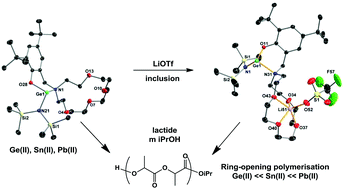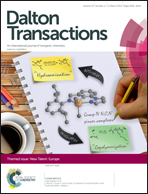Stable germanium(II) and lead(II) amido complexes {LOi}M(N(SiMe3)2) (M = GeII, PbII) bearing amino(ether)phenolate ligands are readily available using the proteo-ligands {LOi}H of general formula 2-CH2NR2-4,6-tBu2-C6H2OH (i = 1, NR2 = N((CH2)2OCH3)2; i = 2, NR2 = NEt2; i = 3, NR2 = aza-15-crown-5) and M(N(SiMe3)2)2 precursors. The molecular structures of these germylenes and plumbylenes, as well as those of {LO3}GeCl, {LO3}SnCl and of the congeneric {LO4}SnII(N(SiMe3)2) where NR2 = aza-12-crown-4, have been determined crystallographically. All complexes are monomeric, with 3-coordinate metal centres. The phenolate systematically acts as a N^Ophenolate bidentate ligand, with no interactions between the metal and the Oside-arm atoms in these cases (for {LO1}−, {LO3}− and {LO4}−) where they could potentially arise. For each family, the lone pair of electrons essentially features ns2 character, and there is little, if any, hybridization of the valence orbitals. Heterobimetallic complexes {LO3}M(N(SiMe3)2)·LiOTf, where the Li+cation sits inside the tethered crown-ether, were prepared by reaction of {LO3}M(N(SiMe3)2) and LiOTf (M = GeII, SnII). The inclusion of Li+ (featuring a close contact with the triflate anion) in the macrocycle bears no influence on the coordination sphere of the divalent tetrel element. In association with iPrOH, the amido germylenes, stannylenes and plumbylenes catalyse the controlled polymerisation of L- and racemic lactide. The activity increases linearly according to GeII ≪ SnII ≪ PbII. The simple germylenes generate very sluggish catalysts, but the activity is significantly boosted if the heterobimetallic complex {LO3}Ge(N(SiMe3)2)·LiOTf is used instead. On the other hand, with 10–25 equiv. of iPrOH, the plumbylenes afford highly active binary catalysts, converting 1000 or 5000 equiv. of monomer at 60 °C within 3 or 45 min, respectively, in a controlled fashion.


 Please wait while we load your content...
Please wait while we load your content...